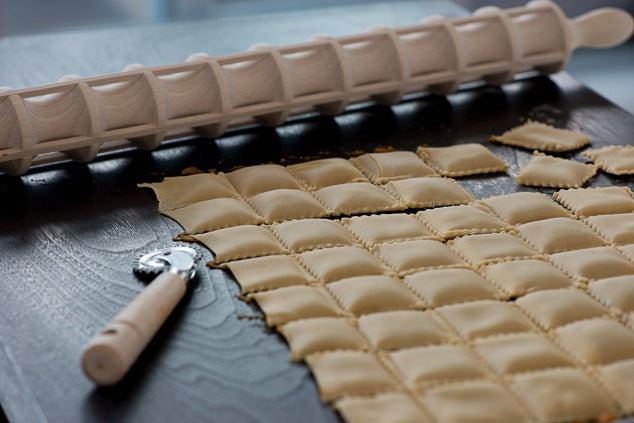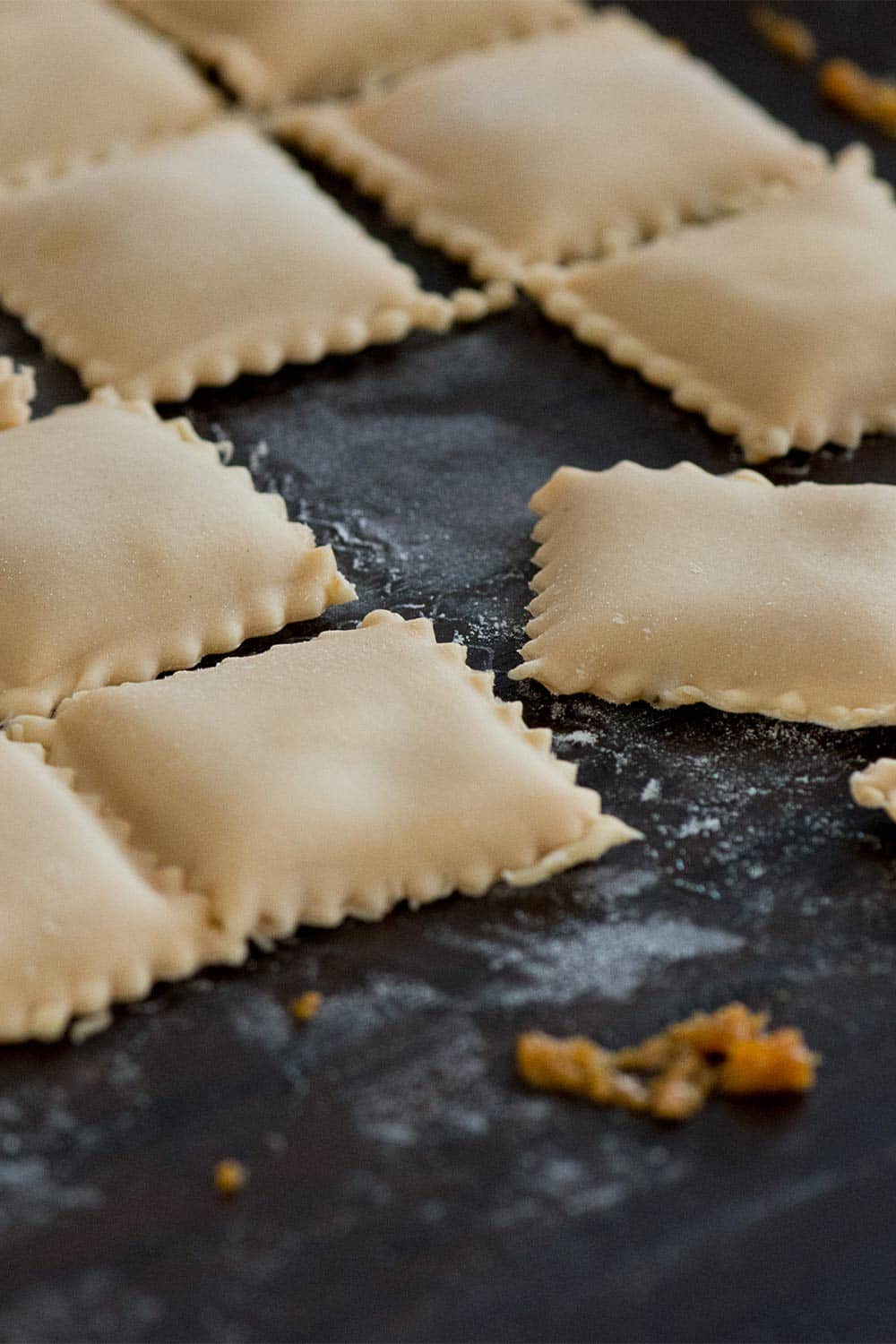
Homemade Ravioli Recipe: How To Use Your Own Ravioli Rolling Pin
-
100 minutes prep time
-
10 minutes cook time
-
Intermediate

Ravioli often are challenging at first - where to start? What equipment? In the past we've written about individually shaped and folded small mouthfuls of pasta, tortellini and tortelloni (tortelloni are slightly larger). There is a recipe for lobster tortellini, and slow-roast shoulder of pork tortelloni. Though delicious and elegant, they are not all that quick - unless you've been practising.
A short history of ravioli
Stuffed pasta (ravioli and tortellini) is believed to have been around since the 16th century. Ravioli can be round, triangular or square in shape, and in northern Italy, is typically only served in a butter sauce.
The filling for ravioli can be meat, cheese or vegetable-based, however the original dish was thought to include a filling of green herbs beaten with egg and fresh cheese.
How to use a ravioli rolling pin
The ravioli rolling pin comes into its own when you want ravioli straight away. In not much more time than it takes to make pasta, you can roll out tens of individual ravioli.
The ravioli rolling pin is perfect for purée-style pasta fillings, spread on a sheet of pasta: finely chopped spinach and ricotta, butternut squash and goats cheese, finely diced woodland mushroom with thyme, or simple ricotta with parmesan and egg.
This nifty kitchen utensil quickly and efficiently shapes and seals ravioli from sheets of fresh pasta. Simply dot your purée filling onto a sheet of pasta, top with the second sheet, then press down on the rolling pin and roll. This encloses the filling between the pasta so it’s ready to cook right away.
Pumpkin and amaretti ravioli recipe
The recipe below for pumpkin and amaretti ravioli is a great place to start when first using a ravioli rolling pin. Pumpkin and amaretti is a classic Italian combination, and a perfect autumn or winter dish. The flavours in the filling are slightly sweet, but the strong savoury notes from the parmesan and sage create balance.

Perfect little parcels of pumpkin & amaretti ravioli
For the pasta Serves: 4
- 400g 00 flour
- 4 medium eggs, beaten
- Semolina flour for dusting
For the ravioli filling
- 1 can pumpkin purée
- 75g amaretti biscuits
- 75g parmesan cheese, finely grated
- Zest of half a lemon
- 1/2 tsp ground nutmeg
- Salt & pepper
To serve
- Parmesan cheese
- 50g Butter
- 8 sage leaves, shredded
First make the pasta dough
- Mix together the eggs and the flour to form a stiff dough. You might need to wipe out the egg bowl with a little of the flour to make sure you have all the egg if the mixture is too dry.
- Knead the dough for 3 to 5 minutes until the surface feels slightly cooler, and when you press your finger into it, the indentation springs back slightly.
- Wrap in clingfilm and leave to rest in the fridge for 30 mins. The dough can keep at this stage up to 48 hours, though if you plan to leave the dough for this long add a tiny amount of lemon juice to the dough to help prevent it discolouring.
Make the filling
- Tip the pumpkin puree into a bowl, and stir in the parmesan, nutmeg, lemon zest, and crushed amaretti biscuits. Season to taste. It will be quite sweet.
Making the ravioli
- Cut the dough into two pieces to make it easier to handle. Remove one from the cling film to work with, and wrap the remainder to keep it moist. Dust the work surface with semolina flour to prevent the rolled pasta from sticking.
- Set the pasta maker at its widest setting. Press the first piece of dough into a long rectangle, and feed through the pasta maker. Fold, and repeat again. Repeat the rolling and folding three or four times - this is like a second 'knead', and the texture will become more elastic.
- Change the dial on the pasta maker to one thickness smaller, and feed the dough through. Keep rolling the dough thinner until you think it is as thin as you can handle. Part way through you might want to cut the dough in half and work on each piece separately.
- When the pasta is at a thickness you can handle, cut it into four equal pieces. Lay two long pieces side by side on the work surface to form a squarish-piece of dough, overlapping by half a centimetre (see picture gallery). Press the seam gently. If you've been working quickly the pasta should stick by itself. If it doesn't seem to, brush with a tiny tiny amount of water to help seal. Repeat with the second two sheets.
- Spread the bottom pasta sheet with half the amaretti mixture. Lay the second sheet on top, and firmly roll over with the ravioli rolling pin. The aim is to stick the pieces of pasta together, but not to cut through it.
- Using the fluted pastry wheel, cut along the edges of the ravioli, taking care not to cut into the parcels themselves. Set aside on a baking sheet dusted with semolina.
- Repeat steps 1-6 with the remaining pasta dough.
To cook
- Simmer for 3 minutes in boiling water.
- Whilst the pasta cooks, melt the butter in a large frying pan. Add the sage leaves, and a few tablespoons of cooking water from the pasta to make an emulsion. Drain the pasta, and add to the sage-butter frying pan. Toss well.
- Serve with a sprinkle of parmesan cheese
Shop all pasta making equipment, and try our cacio e pepe recipe.

Now you've mastered the art of ravioli, buy some dumpling flour and test your skills at dumpling making!


